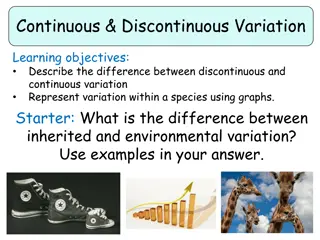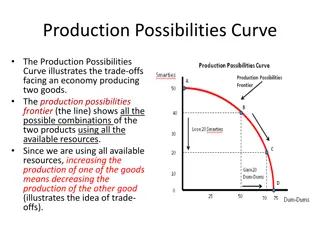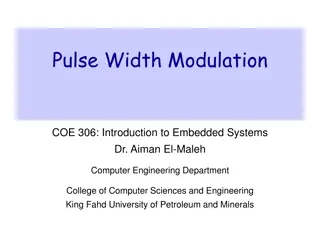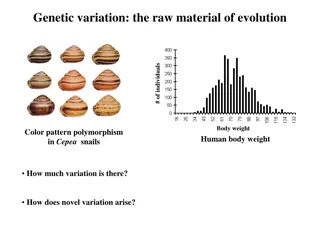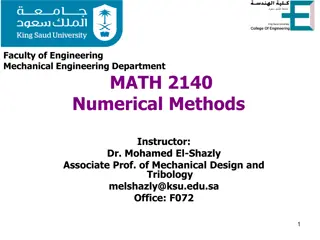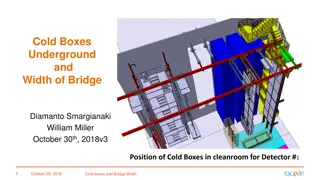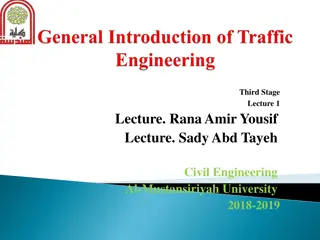Understanding Traffic Lane Width Variation in Curve Bridge Design
In curve bridge design, traffic lane width may vary, requiring proper consideration of surface lanes for defining traffic lanes. Non-square elements, like triangular plates, may be used at deck ends due to geometric limitations. Different mesh local axes may be needed for square and non-square elements. Wheel spacings are crucial for modeling vehicles in bridge design, following specific code configurations. Varying wheel spacings in the longitudinal direction are possible, but not in the transverse direction.
Download Presentation

Please find below an Image/Link to download the presentation.
The content on the website is provided AS IS for your information and personal use only. It may not be sold, licensed, or shared on other websites without obtaining consent from the author. Download presentation by click this link. If you encounter any issues during the download, it is possible that the publisher has removed the file from their server.
E N D
Presentation Transcript
Name : Wee Lin Chong Name : Wee Lin Chong Q1. usually in curve bridge like ramp, the traffic lane width is varying. in this case, is surface lane is still applicable? Mak. lane . Yes, it is applicable. It has to be. The only method to define traffic lanes on plate elements is by using surface Surface lane is not a mechanical term. It is just a name given by the software to differentiate it from line lane , which is another name given by the software for its method to define traffic lanes on stick elements. If the deck width is varying, I suppose there will be a position within the deck where a lane (or lanes) would have to end. To define a short traffic lane, simply select those relevant nodes that are located before the end of the lane, to be the reference nodes when defining the lane. MIDAS Academy 1
Name : Tyng Feng Name : Tyng Feng Chae Chae Q1. why there are some triangular plates at the end of the deck and intermediate deck? Mak. for your download, refer to slide 4. I suppose you did not join Day 1 of the webinar. It is alright. When the presented slides for Day 2 becomes available For an irregularly shaped deck, there shall be locations where square elements are just not possible, simply due to geometrical limitations. This is when non-square elements would have to used. If these areas are left empty, the model and the analysis could not simulate the behaviour of the complete deck, and the results would be that much more inaccurate. MIDAS Academy 2
Name : Wai Seng Chai Name : Wai Seng Chai Q1. Hi Mak, is the triangle mesh local axis is rotated to match the local axis vector of the rectangle one? Mak. square/rectangular elements. These should be treated separately if the software has not. For MIDAS Civil, instead of bending moment about local axes, bending moments about your intended reinforcement directions (including skewed reinforcements) can be found directly, and can then be used for reinforcement design conveniently. Not necessarily. There would be some non-square/non-rectangle elements with local axes different from the majority MIDAS Academy 3
Name : Da Huang Name : Da Huang Q1. The wheel spacing 1m is only applied to the specified vehicles you are modelling? If the moving load is standard loading specified in he code, what is the wheel spacing should we use? It is applied to all the vehicles. The default value follows the design code. It is opened to the users incase they want to use their own vehicles. Q2. What is wheel spacing when define traffic lane? It is wheel spacing in the transverse direction. The spacing of longitudinal direction can be defined on Vehicles function. Q3. How about if there are various wheel spacing for the specific traffic loading? It is not possible to define various wheel spacing in the transverse direction of the vehicles. But it is possible for longitudinal direction. Mak 1. Every code has its own specific traffic load configuration. For the code that was used for this bridge, the configuration of a HB vehicle is as shown here in Figure 12 for your easy understanding. There is not a standard traffic load for all codes. Mak 2. parameters that will appear in all codes. For instance, a code may specify only uniformly distributed load without any wheel, and would thus have no mentioning of wheel spacing at all. Wheel spacing is also not a standard See Figure 12 here. For the code that was used for this bridge, wheel spacing means the three 1 m spacings between adjacent wheels in the transverse direction to the vehicle moving direction. MIDAS Academy 4
Mak 3. indeed there is such a vehicle specified in the code we are using, and MIDAS Civil has not included that code, we as engineers, have to think of alternative way(s) to apply the loads. This is what structural engineers have to do. Software are just tools to help engineers, and no tool is perfect. For the code that was used for this bridge, it has not any specification for a wheel-spacing-varying vehicle. If MIDAS Academy 5
Name : Name : Iyamperumal Iyamperumal M M Q1. what is the normal analysis time in fem model for moving load case? There are so many factors which can affect on analysis time. You can reduce the time with Analysis Control menu as the speaker did. It depends on the number of elements, what kinds of parameters you would like to see as results. It will be only few seconds if there are less than,, let's say 100 beam elements. But this is not accurate number. Mak. structure, complexity of the structure, number of elements, types of load (e.g. creep, shrinkage, temperature, differential settlement), etc. In fact, everything plays apart in affecting the analysis time, even your computer speed. I remember from my experience, the longest it took was about 2 hours. I suppose you have seen the organiser s answer to you. It is correct. It depends on many factors: size of the MIDAS Academy 6
Name : Say Name : Say Kee Kee Saw Saw Q1. Why the WA Moment Top Dir 2 is smaller than Ma/Mb? It is incorrect for the speaker to say that the twisting moment will always add to the normal bending moment. The speaker performed a study on a plate example, and has found that there are indeed occasions when the twisting moment will reduce the normal bending moment, and the resulting W-A moment be lesser than the normal bending moment. The example is as shown below. A plate element with bending moments ma, mb, and mab, where is the moment along a-a axis, not about; is the moment along b-b axis, and b-b axis is perpendicular to a-a axis; is the twisting moment. ma mb mab is to be designed with intended reinforcement directions: main reinforcement parallel to a-a axis; parallel to b-b axis (90 to a-a axis). secondary reinforcement The findings are shown in the following slides. (For definition of other symbols, and the equation for calculating Wood-Armer Moments, please refer to MIDAS Civil help .) MIDAS Academy 7
Appendix A Post-webinar correction on W-A Moment MIDAS Academy 8
Appendix A Post-webinar correction on W-A Moment MIDAS Academy 9
In the above example, there are three occasions (as circled red above) when W-A Moment will be lesser than the normal bending moment in the respective axis. The speaker apologises for his incorrect explanations during the webinar, and would like to thank you for bringing up this question, and letting him have a chance to self-correct and learn from. MIDAS Academy 10
Name : Ever Sim Name : Ever Sim Q1. What s the mesh size? 500x500? Q2. For the mesh plate which intersect between pedestrian and traffic lane LL, will the force double up? It is not a mesh with consistent plate element size. Most of the elements are 500 mm 500 mm squares, but Mak 1. some others are rectangles, triangles, trapezoids of different sizes. Mak 2. a portion of an element and another lane covering the rest of the element. In the latter case, yes, loads from both lanes would be acting on that element. But that should not be understood as doubling up the load If one element is at such a position that it is sustaining loads from two lanes, it should be designed to account for the loads. If we zoom in, we can see that there are no two lanes overlapping each other, but there could be one lane covering MIDAS Academy 11
Name : Fiona Tan Name : Fiona Tan Q1. are the node of the dummy beam same as the node of the plates? Yes, beam and plate elements are sharing the nodes Mak. space that you model your structure. All components stick, plate, or even solid elements are created by connecting these nodes. The software knows where each component is, and what the whole structure is like, by knowing the coordinates of these positioning points . Yes. Maybe I made it complicated for you, but don t let me. Simply think of each node as a positioning point in the MIDAS Academy 12
Name : Laura Ting Name : Laura Ting Q1. what is the difference between active and active plus? Active is to activate only the selected item and Active plus is adding the activation of selected item to the current activated node/elements Mak. Active is how MIDAS describe those element being shown on the screen. When we select node(s)/element(s) and click active , only those selected node(s)/element(s) will be shown, and all the others will be hidden. If we now select the others by right-clicking on the Tree Menu and click active again, only the others will be shown, and those previous node(s)/element(s) will be hidden. In order to show both groups of nodes/element(s) together, we should click active plus in the second operation. That is the what the plus term means. MIDAS Academy 13
Name : Sui Name : Sui Kieng Kieng Wong Wong Q1. the wheel spacing is specified to the spacing between wheel distance between front and back? for heavy trailer which may have many wheels, how do specify the wheel distance? Wheel Spacing on Traffic Lanes dialog is the spacing in the transverse direction. The longitudinal spacing can be defined on Vehicles function. Also, midas Civil provides user defined vehicle function so the users are able to apply whatever the number of axles. Q2. is there anyway to see the combination factor applied by the software for the live load? It is written on Results menu - Load combination - Auto generation Mak 1. For the code that was used for this bridge, wheel spacing means the three 1 m spacings between adjacent wheels in the transverse direction to the vehicle moving direction. For your easy understanding, see Figure 12 here. Every code has their own specifications to traffic load configuration. This configuration is not a replicate of actual vehicles. It is a load system that is applied to the structure during design stage to simulate the worst loading scenario that the code has considered. If indeed, the code has specified a heavy trailer , the wheel distances should have also been specified by the same code. Mak 2. is used. These factors are defined by the code, not the software. For this bridge, the code used is BD 37/01, and the factors are tabulated in Table 1, Volume 1, Section 3, Part 14. The factors should be found in the design code that MIDAS Academy 14
Name : Name : Eko Eko Abadi Abadi Q1. Could you please share tips to create the polyline quickly for the curved dummy element? and also how did you create all the rectangular / triangular /square elements in CAD files? any tips to do it quickly? Mak. created them, was simply drawing them out one by one. The dummy elements are a series of straight lines joining each adjacent node along the inner curve edge. The way I The plate elements across the deck area are each a separate single object. The way I created them, was by using command of either RECTANGULAR (REC), POLYLINE (PL), or LINE (L) and COMBINEPOLYLINES (PE). Depending on our drafting software and our skill in using them differently, the way to create a line or a polygon as a single object could be different. You may find better answers from your colleague from the drafting department. MIDAS Academy 15




